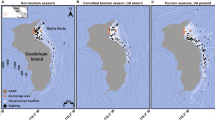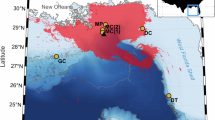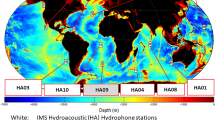Abstract
Zooplankton underpin the health and productivity of global marine ecosystems. Here we present evidence that suggests seismic surveys cause significant mortality to zooplankton populations. Seismic surveys are used extensively to explore for petroleum resources using intense, low-frequency, acoustic impulse signals. Experimental air gun signal exposure decreased zooplankton abundance when compared with controls, as measured by sonar (~3–4 dB drop within 15–30 min) and net tows (median 64% decrease within 1 h), and caused a two- to threefold increase in dead adult and larval zooplankton. Impacts were observed out to the maximum 1.2 km range sampled, which was more than two orders of magnitude greater than the previously assumed impact range of 10 m. Although no adult krill were present, all larval krill were killed after air gun passage. There is a significant and unacknowledged potential for ocean ecosystem function and productivity to be negatively impacted by present seismic technology.
This is a preview of subscription content, access via your institution
Access options
Access Nature and 54 other Nature Portfolio journals
Get Nature+, our best-value online-access subscription
$29.99 / 30 days
cancel any time
Subscribe to this journal
Receive 12 digital issues and online access to articles
$119.00 per year
only $9.92 per issue
Buy this article
- Purchase on SpringerLink
- Instant access to full article PDF
Prices may be subject to local taxes which are calculated during checkout





Similar content being viewed by others
References
Alcaraz, M. & Calbet, A. Zooplankton Ecology (Encyclopedia of Life Support Systems, 2009).
Raymont, J. E. G. Plankton and Productivity in the Oceans Vol. 2 (Pergamon, 1983).
Richardson, A. J. In hot water: zooplankton and climate change. ICES J. Mar. Sci. 65, 279–295 (2008).
U.S. Geological Survey World Conventional Resources Assessment Team Supporting Data for the U.S. Geological Survey 2012 World Assessment of Undiscovered Oil and Gas Resources U.S. Geological Survey Digital Data Series DDS–69–FF (USGS, 2013); http://pubs.usgs.gov/dds/dds-069/dds-069-ff/
An Overview of Marine Seismic Operations Report 448 (OGP and IAGC, 2011); http://www.iogp.org/bookstore/product/an-overview-of-marine-seismic-operations/
Industry Statistics (APPEA, 2016); http://www.appea.com.au/industry-in-depth/industry-statistics/
Ivanova, A. et al. Monitoring and volumetric estimation of injected CO2 using 4D seismic, petrophysical data, core measurements and well logging: a case study at Ketzin, Germany. Geophys. Prospect. 60, 957–973 (2012).
Richardson, W. J., Greene, C. R., Malme, C. I. & Tomson, D. H. Marine Mammals and Noise (Academic, 1995).
Popper, A. N. & Hastings, M. C. The effects on fish of human-generated (anthropogenic) sound. Integr. Zool. 4, 43–52 (2009).
Pearson, W. H., Skalski, J. R. & Malme, C. I. Effects of sounds from a geophysical survey device on behaviour of captive rockfish (Sebastes spp.). Can. J. Fish. Aquat. Sci. 49, 1343–1356 (1992).
Fewtrell, J. L. & McCauley, R. D. Impact of airgun noise on the behaviour of marine fish and squid. Mar. Pollut. Bull. 64, 984–993 (2012).
Neo, Y. Y. et al. Impulsive sounds change European seabass swimming patterns: influence of pulse repetition interval. Mar. Pollut. Bull. 97, 111–117 (2015).
McCauley, R. D., Fewtrell, J. & Popper, A. N. High intensity anthropogenic sound damages fish ears. J. Acoust. Soc. Am. 113, 638–642 (2003).
Kostyuchenko, L. P. Effects of elastic waves generated in marine seismic prospecting on fish eggs in the Black Sea. Hydrobiol. J. 9, 45–48 (1971)
Dalen, J. & Knutsen, G. M. in Progress in Underwater Acoustics (ed. Merklinger, H. M. ) 93–102 (Plenum, 1986).
Hawkins, A. D. Pembroke, A. E. & Popper, A. N. Information gaps in understanding the effects of noise on fishes and invertebrates. Rev. Fish. Biol. Fish. 25, 39–64 (2015).
Day, R. D., McCauley, R. D., Fitzgibbon, Q. P. & Semmens, J. M. Assessing the Impact of Marine Seismic Surveys on Southeast Australian Scallop and Lobster Fisheries Final Report 2012-008-DLD (FRDC, 2016); http://frdc.com.au/research/final-reports/Pages/2012-008-DLD.aspx
de Soto, N. A. et al. Anthropogenic noise causes body malformations and delays development in marine larvae. Sci. Rep. 3, 2831 (2013).
Day, R. D. et al. Seismic air gun exposure during early-stage embryonic development does not negatively affect spiny lobster Jasus edwardsii larvae (Decapoda: Palinuridae). Sci. Rep. 6, 22723 (2016).
Yen J., Rasberry, K. D. & Webster, D. R. Quantifying copepod kinematics in a laboratory turbulence apparatus. J. Mar. Syst. 69, 283–294 (2008).
McManus, M. A. & Woodson, C. B. Plankton distribution and ocean dispersal. J. Exp. Biol. 215, 1008–1016 (2012).
Bianco, G. et al. Analysis of self-overlap reveals trade-offs in plankton swimming trajectories. J. R. Soc. Interface 11, 20140164 (2014).
Visser, A. W. Motility of zooplankton: fitness, foraging and predation. J. Plank. Res. 29, 447–461 (2007).
McCauley, R. D., Duncan, A. J., Gavrilov, A. N. & Cato, D. H. Transmission of marine seismic survey, air gun array signals in Australian waters. In Proc. ACOUSTICS 2016 (eds Hillock, I. D. M. & Mee, D. J.) 1–10 (Acoustics Australia, 2016).
McCauley, R. D. in Environmental Implications of Offshore Oil and Gas Development in Australia: The Findings of an Independent Scientific Review (eds Swan, J. M., Neff, J. M. & Young P. C. ) 19–122 (APPEA, 1994).
Budelmann, B. B. in The Evolutionary Biology of Hearing: Hearing in Nonarthropod Invertebrates (eds Webster, D. B. et al.) Ch. 10, 141–155 (Springer, 1992).
Lenz, P. H., Weatherby, T. M., Weber, W. & Wong, K. K. Sensory specialization along the first antenna of a calanoid copepod, Pleuromamma xiphias (Crustacea). Mar. Freshw. Behav. Physiol. 27, 213–221 (1996).
Weatherby, T. M. & Lenz, P. H. Mechanoreceptors in calanoid copepods: designed for high sensitivity. Arthropod Struct. Dev. 29, 275–288 (2000).
Buskey, E. J., Lenz, P. H. & Hartline, D. K. Sensory perception, neurobiology, and behavioral adaptations for predator avoidance in planktonic copepods. Adapt. Behav. 20, 57–66 (2011).
McCauley, R. D . et al. in Environmental Implications of Offshore Oil and Gas Development in Australia: Further Research 364–521 (APPEA, 2003).
Motoda, S. Devices of simple plankton apparatus. Mem. Fac. Fish. Hokkaido Univ. 7, 73–94 (1959).
Elliott, D. T. & Tang, K. W. Simple staining method for differentiating live and dead marine zooplankton in field samples. Limnol. Oceanogr. Meth. 7, 585–594 (2009).
Acknowledgements
The authors acknowledge the fieldwork contributions of IMAS staff, particularly M. Porteus, L. Watson, J. Beard, A. Pender, J. McAllister and A. Walters. M. Perry and D. Minchin of Curtin University prepared air gun and acoustic gear. This study was supported by University of Tasmania Research Enhancement Grant Scheme D0022818. R.A.W. acknowledges support from the Australian Research Council (Discovery project DP140101377). All research was conducted in accordance with University of Tasmania Animal Ethics Committee permit A13328. Fieldwork was conducted in accordance with Tasmania Department of Primary Industries, Parks, Water and Environment permits 13011 and 14038. R. Towler (Midwater Assessment and Conservation Engineering, NOAA Alaska Fisheries Science Center) produced a modified package for reading the sonar raw data files into MATLAB.
Author information
Authors and Affiliations
Contributions
R.D.M., R.D.D., Q.P.F. and J.M.S. conceived the study, with R.D.M. setting the initial study plan based on previous experiences. All authors but R.A.W. contributed to the final study design and field planning. R.D.M. and R.D.D. collected field data. K.M.S. and R.D.D. analysed plankton tows. R.D.M. analysed air gun and sonar data, and wrote the main manuscript. All authors reviewed and revised the manuscript.
Corresponding authors
Ethics declarations
Competing interests
The authors declare no competing financial interests.
Supplementary information
Supplementary Information
Supplementary Figures 1–4; Supplementary Tables 1–6 (PDF 708 kb)
Rights and permissions
About this article
Cite this article
McCauley, R., Day, R., Swadling, K. et al. Widely used marine seismic survey air gun operations negatively impact zooplankton. Nat Ecol Evol 1, 0195 (2017). https://doi.org/10.1038/s41559-017-0195
Received:
Accepted:
Published:
DOI: https://doi.org/10.1038/s41559-017-0195



